

List of Psychological Disorders - A List of Psychological Disorders. Psychological disorders, also known as mental disorders, are patterns of behavioral or psychological symptoms that impact multiple areas of life.
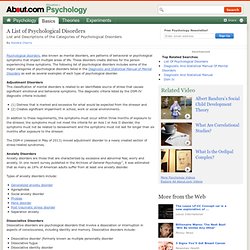
These disorders create distress for the person experiencing these symptoms. The following list of psychological disorders includes some of the major categories of psychological disorders listed in the Diagnostic and Statistical Manual of Mental Disorders as well as several examples of each type of psychological disorder. Adjustment Disorders This classification of mental disorders is related to an identifiable source of stress that causes significant emotional and behavioral symptoms.
The diagnostic criteria listed by the DSM-IV diagnostic criteria included: Hyperactive neurons build brains in synaesthesia - health - 17 November 2011. Neurons with hyperactive tendencies may help to explain the mysterious mechanisms that cause synaesthesia.

The discovery could help develop treatments for other visual anomalies such as hallucinations. Grapheme-colour synaesthesia is a condition in which an individual's sense of numbers or letters is associated with different colours. To identify its causes, Devin Terhune and his colleagues at the University of Oxford enlisted the help of six people with the unusual condition. First the team applied transcranial magnetic stimulation to an area of each volunteer's brain called the primary visual cortex to evoke phosphenes – tiny visual disturbances often seen after looking directly at a bright light.
The volunteers needed a third of the stimulation that non-synaesthetes needed to evoke the phosphenes. Colourful origins His team suspected that these hyperactive neurons might play a role in the participants' synaesthesia. Mind and metaphor. ThePhobia List - StumbleUpon. What happens when your brain is split in two - and you survive? Neurons Offer Clues to Suicide. A certain type of brain cell may be linked with suicide, according to a recent investigation.
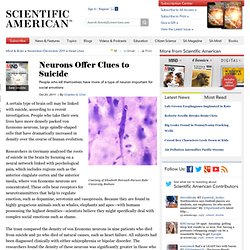
People who take their own lives have more densely packed von Economo neurons, large spindle-shaped cells that have dramatically increased in density over the course of human evolution. Researchers in Germany analyzed the roots of suicide in the brain by focusing on a neural network linked with psychological pain, which includes regions such as the anterior cingulate cortex and the anterior insula, where von Economo neurons are concentrated. These cells bear receptors for neurotransmitters that help to regulate emotion, such as dopamine, serotonin and vasopressin. A form of blindness where you can see everything, but recognize nothing. While I cannot speak to the other forms of agnosia, prosopagnosia is not necessarily caused by trauma to the head.
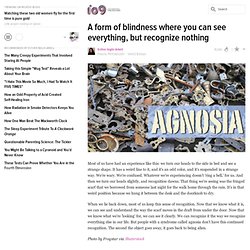
I was diagnosed with it about a year ago, and like the person mentioned in the article, did not recognise that something was wrong until recently. I always had trouble recognising people, even my own family, and thought it was normal to not actually be able to recall the specifics of a person's face. I would often pretend to just have bad eyesight, and squint when I was looking for someone in a crowd, in order to cover up the fact that I couldn't pick out a single person there.
When watching movies or tv shows, I cannot handle plot lines where characters disguise themselves or pretend to be someone else, or with duplicitous characters who pretend to be the hero's ally but are secretly lurking behind the scenes, plotting to bring them down. I love sitcoms because the actors rarely look different, it's so much easier to learn who is who. Autistic people superior in multiple areas: Scientists must stop emphasizing autistics' shortcomings, expert urges.
We must stop considering the different brain structure of autistic individuals to be a deficiency, as research reveals that many autistics -- not just "savants" -- have qualities and abilities that may exceed those of people who do not have the condition, according to a provocative article published November 2 in Nature by Dr.
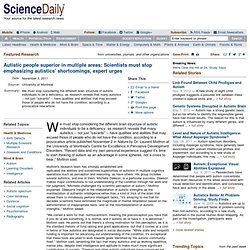
Laurent Mottron at the University of Montreal's Centre for Excellence in Pervasive Development Disorders. "Recent data and my own personal experience suggest it's time to start thinking of autism as an advantage in some spheres, not a cross to bear," Mottron said. Mottron's research team has strongly established and replicated the abilities and sometimes superiorities of autistics in multiple cognitive operations such as perception and reasoning, as have others. His group includes several autistics, and one of them, Michelle Dawson, is a particular success. Dawson makes major contributions to our understanding of the condition through her work and her judgment. Treatment with light benefits Alzheimer's patients, Wayne State University finds. Public release date: 11-Jan-2012 [ Print | E-mail Share ] [ Close Window ] Contact: Julie O'Connorjulie.oconnor@wayne.edu 313-577-8845Wayne State University - Office of the Vice President for Research Detroit - Exposure to light appears to have therapeutic effects on Alzheimer's disease patients, a Wayne State University researcher has found.

Charles Bonnet syndrome. Charles Bonnet syndrome (CBS) is the experience of complex visual hallucinations in patients with visual loss.
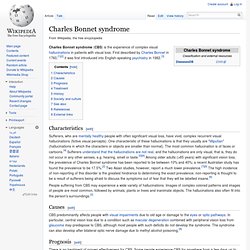
First described by Charles Bonnet in 1760,[1][2] it was first introduced into English-speaking psychiatry in 1982.[3] Characteristics[edit] Sufferers, who are mentally healthy people with often significant visual loss, have vivid, complex recurrent visual hallucinations (fictive visual percepts). One characteristic of these hallucinations is that they usually are "lilliputian" (hallucinations in which the characters or objects are smaller than normal). 10 Psychological States You've Never Heard Of — And When You Experienced Them. 10 Incredibly Strange Brain Disorders.
Outbreeding depression. In biology, outbreeding depression occurs when offspring from crosses between individuals from different populations have lower fitness than progeny from crosses between individuals from the same population.[1] The concept is opposed to inbreeding depression.

This phenomenon can occur in two ways. First, intermediate genotypes may be disfavored. For example, selection in one population might produce a large body size, whereas in another population small body size might be more advantageous. Madonna–whore complex. In sexual politics the view of women as either Madonnas or whores limits women's sexual expression, offering two mutually exclusive ways to construct a sexual identity.[4] The term is also used popularly, often with subtly different meanings.
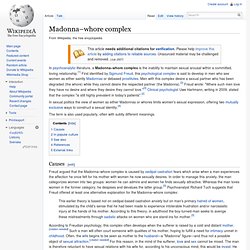
Causes[edit] Freud argued that the Madonna–whore complex is caused by oedipal castration fears which arise when a man experiences the affection he once felt for his mother with women he now sexually desires. In order to manage this anxiety, the man categorizes women into two groups: women he can admire and women he finds sexually attractive. Whereas the man loves women in the former category, he despises and devalues the latter group.[5] Psychoanalyst Richard Tuch suggests that Freud offered at least one alternative explanation for the Madonna–whore complex:
Oliver_Sacks_-_The_Man_Who_Mistook_His_Wife_For_A_ How to Live With an Unknowable Mind. We know surprisingly little about our own personalities, attitudes and even self-esteem.

How do we live with that? How do you imagine your own mind? I sometimes picture mine as a difficult and contrary child; the kind that throws a stone at you for no reason and can’t explain itself. Or while at the beach it sits silent, looking miserable. But, at a wedding is determined to scream at the top of its lungs through all the quiet bits. One reason minds can be frustrating is that we only have access to part of them, by definition the conscious part. Except we don’t know it’s doing things we haven’t asked it to, because we can’t interrogate it. This is quite a different view of the mind than Freud had. The idea that large parts of our minds can’t be accessed is fine for basic processes like movement, seeing or hearing. Other parts would be extremely interesting to know about. Medical Mystery: How Can Some People Hear Their Own Eyeballs Move?
Depressive realism. Evidence for[edit] Evidence against[edit] When asked to rate both their performance and the performance of another, non-depressed individuals demonstrated positive bias when rating themselves but no bias when rating others. Criticism of the evidence[edit] Some have argued that the evidence is not more conclusive because there is no standard for "reality," the diagnoses are dubious, and the results may not apply to the real world.[33] Because many studies rely on self-report of depressive symptoms, the diagnosis of depression in these studies may not be valid as self-reports are known to often be biased, necessitating the use of other objective measures.
Due to most of these studies using designs that do not necessarily approximate real-world phenomena, the external validity of the depressive realism hypothesis is unclear. See also[edit] References[edit] Jump up ^ Alloy,L.B., Abramson,L.Y. (1988). Top 10 Mental Illnesses And Their Myths. Humans We’ve had several fascinating lists about bizarre mental disorders on this site, but no lists have been posted of mental illness myths. Mental illnesses, disorders and differences tend to be very misunderstood by the general public. This is a list of mental illnesses and a widely believed myth or two about each one. I’m sure there are other mental disorders with myths so widespread that I believe in them, too. Of course, you can tell me about those in the comments. Alien Hand Syndrome sees woman attacked by her own hand.